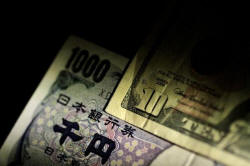Dollar slides against the yen on global trade tensions;
Norwegian crown jumps
 Send a link to a friend
Send a link to a friend
 [March 15, 2018]
By Tommy Wilkes [March 15, 2018]
By Tommy Wilkes
LONDON (Reuters) - The dollar fell against
the yen on Thursday as trade tensions encouraged investors to buy the
Japanese currency, while the crown rose to its highest in four months
after the Norwegian central bank signaled an earlier rate rise.
Traders are concerned about a U.S. shift towards increased protectionism
under Donald Trump's administration, with Wall Street rattled on
Wednesday after the president sought to impose fresh tariffs on China.
The yen is expected to benefit from any increase in trade protectionism,
given Japan's strong current account surplus and the currency's
reputation as a safe haven.
"There is still uncertainty when it comes to U.S. politics that is
keeping risk appetite limited and that is keeping the yen in demand,"
said Manuel Oliveri, an FX strategist at Credit Agricole.
The yen, which began the year trading around 113 yen per dollar, rose
0.4 percent to 105.95 <JPY=>. In earlier Asian trading it had increased
to 105.79, its strongest since March 7.

The Trump administration is pressing China to cut its trade surplus with
the United States by $100 billion, fanning fears of a broader tit-fot-tat
trade war.
Larry Kudlow, the incoming director of the White House national economic
council, said on Wednesday that China had earned a tough response from
the United States and other countries on trade, even though he has
previously criticized "blanket" tariffs.
In an interview with CNBC, Kudlow said he would like to see the dollar a
"wee bit stronger than it is currently".
The euro edged 0.1 percent lower to $1.2352 <EUR=>, as the dollar gained
slightly versus a basket of currencies <.DXY>.
POLICY DECISIONS
The Norwegian central bank kept rates on hold at 0.5 percent on Thursday
but said it expected to raise rates after the summer, "somewhat earlier"
than a previously forecast December hike.
[to top of second column] |

U.S. Dollar and Japan Yen notes are seen in this June 22, 2017
illustration photo. REUTERS/Thomas White/Illustration

That sent the crown up as much as 0.7 percent to 9.4760 crowns per euro <EURNOK=>,
the highest level since November. It later gave up some of those gains and
traded up 0.4 percent at 9.5165 crowns per euro.
"The divergence between the Norges bank and the other central banks is crystal
clear," said Petr Krpata, FX and Rates strategist at ING, referring to the
central banks in the euro zone, Switzerland and Sweden that are sticking with
dovish policies.
Krpata said further gains for the crown depended on the oil price - a major
earner for the Norwegian economy - as much of the hawkish tilt in Norway had now
been priced in to the currency.
The Swiss Central Bank also met on Thursday, keeping its ultra-loose monetary
policy in place. The franc was largely unmoved, trading at 1.169 francs per euro
<EURCHF=>.
The Swiss franc has been falling heavily since last year versus the euro on bets
the SNB will be one of the last banks to end its easy-money policies.
The New Zealand dollar came under pressure after mixed economic growth data
there cemented bets on interest rates staying at record lows for a long time
yet.
The kiwi slipped to $0.7296 <NZD=D3> in European trading after the fourth
quarter GDP data.
(editing by John Stonestreet and Dasha Afanasieva)
[© 2018 Thomson Reuters. All rights
reserved.] Copyright 2018 Reuters. All rights reserved. This material may not be published,
broadcast, rewritten or redistributed.
Thompson Reuters is solely responsible for this content.
 |